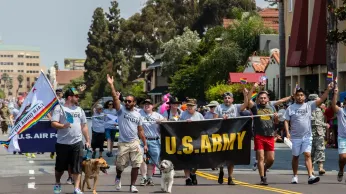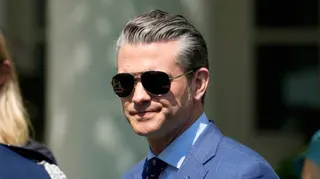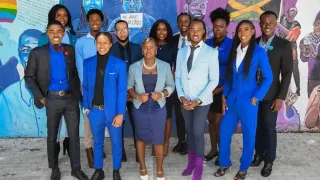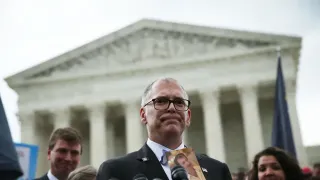
6 hours ago
We’ve Always Been Here: The Unbreakable Legacy of Trans Service Members in America’s Military
READ TIME: 4 MIN.
There’s something uniquely American about fighting for both your country and your right to exist. To be a transgender person in the U.S. military is to walk a tightrope of identity, patriotism, and policy—often in boots, sometimes in heels, and always with an iron-willed resolve that has shaped the very fabric of American defense. As the headlines ping-pong from bans to breakthroughs, it’s time to take a wider, deeper look at the full, unvarnished history of trans service members: a chronicle not of mere survival, but of persistent, undeniable presence.
Transgender people have worn the uniform for generations, often under the radar. For decades, military policies classified transgender identity as a “psychosexual disorder,” a label used to bar trans people from serving openly or to discharge those discovered to be living as their true selves. The shadow of “Don’t Ask, Don’t Tell” loomed large, ending in 2011 for gay, lesbian, and bisexual troops, but leaving trans service members in a policy limbo that would persist for years.
“Don’t Ask, Don’t Tell” may have been repealed, but for trans people, the battle for open service was far from over. As late as 2015, the Department of Defense still maintained explicit bans on open trans service, citing outdated medical rationales. Yet, in that same year, trailblazers like Sgt. Shane Ortega and Airman Logan Ireland stepped into the media glare, coming out publicly and demanding the right to serve authentically. Their courage wasn’t just about personal liberation—it was a rallying cry for visibility, acceptance, and the simple truth: trans people are integral to our national defense.
July 2016 marked a seismic shift: Defense Secretary Ash Carter announced that transgender individuals could no longer be discharged or denied reenlistment due to their gender identity, opening the door for trans service members to serve openly for the first time in history. The military, in that moment, became a little more honest—a little more reflective of the diversity that’s always powered its ranks.
Then came the backlash. In July 2017, President Trump took to Twitter, declaring a return to the ban on transgender service members, citing concerns over medical costs and military readiness—a claim widely refuted by both medical experts and military leaders. The ban, formalized in March 2018, blocked those with a history of gender dysphoria from enlisting and forced currently serving troops to remain, if at all, according to their assigned sex at birth.
Legal battles blazed. Plaintiffs like Cathrine Schmid, supported by organizations such as the Human Rights Campaign and the Gender Justice League, challenged the ban in federal court, sparking a national conversation about fairness, equality, and the real meaning of military service. Though the Supreme Court allowed the ban to take effect in 2019, it declined to rule on the lawsuits, leaving the future uncertain and the fight far from over.
Despite every ban, reversal, and policy whiplash, the presence of trans service members is undeniable. Research suggests that approximately 15,500 transgender people currently serve in active duty or in the National Guard and Reserve forces, with at least 134,000 trans veterans or retirees. These numbers aren’t just statistics—they’re proof of a legacy of service that has defied discrimination at every turn.
Trans service members fill every role: aviators, SEALs, medics, officers, and infantry. Their stories are as varied as the rainbow itself—some serving in silence, others out and proud, and all united by a singular commitment to defending their country. One trans soldier, reflecting on the right to wear the Army uniform, summed up the emotional complexity: “I fought for this country in this uniform. It fits me because it’s mine, and I’ve earned it”.
The battle for trans military inclusion isn’t just about policy—it’s about visibility, cultural respect, and the right to belong. For LGBTQ+ communities, the military’s shifting stance on transgender service is a microcosm of the larger struggle for queer rights: the push and pull between progress and prejudice, between recognition and erasure.
Trans veterans have always been part of the story. Their resilience, ingenuity, and leadership have shaped countless units, missions, and lives—not just as soldiers, but as trailblazers for LGBTQ+ inclusion. Their presence forces the nation to confront uncomfortable truths: that patriotism isn’t a cisgender privilege, that courage isn’t limited by gender identity, and that the military is strongest when it reflects the diversity of the nation it serves.
For LGBTQ+ readers, the saga of trans service members is both a rallying cry and a reminder: you have always belonged, even in places that once tried to push you out. The fight for trans inclusion in the military is ongoing, but every victory—and every act of resistance—adds another thread to the quilt of queer American history.
As policy battles continue, trans service members and veterans remain at the forefront of a movement for full equality. Their visibility is essential—not just for their own rights, but for the health and well-being of all LGBTQ+ troops. Organizations like the Military and Veterans Program at the USC Suzanne Dworak-Peck School of Social Work continue to champion their rights, advocating for better integration, support, and healthcare.
Trans service members have shown the nation what true resilience looks like. Their stories aren’t just about overcoming—they’re about thriving. As one trans veteran said, “We are here. We have always been here. And we’re not going anywhere”.
So as debates rage and policies shift, remember: every time a trans person puts on the uniform, they’re making history—not just for themselves, but for every queer person who dreams of serving, belonging, and being seen.






